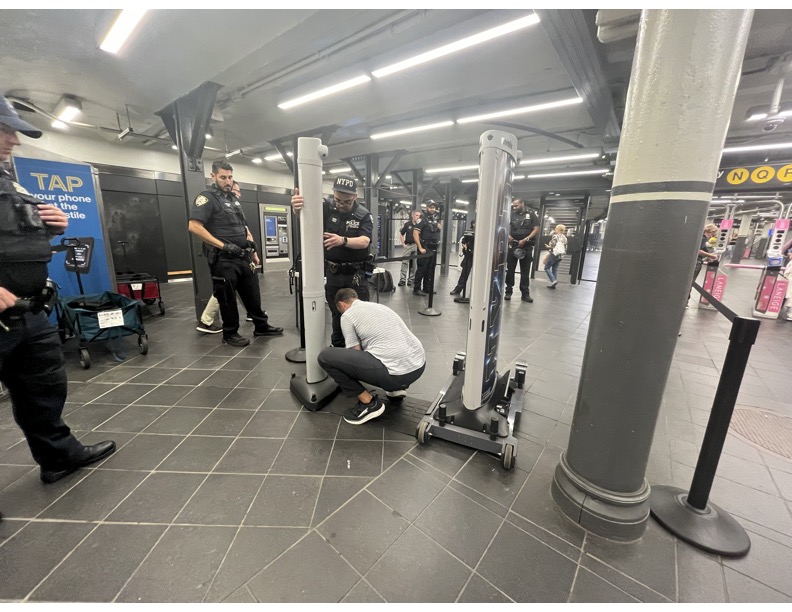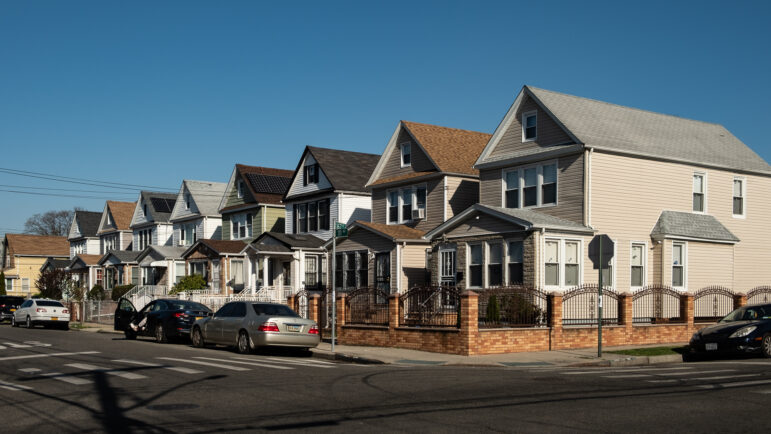The NYPD said Thursday that the month-long gun detector pilot yielded 12 knives, 118 false positives, and zero firearms. City Limits’ CLARIFY youth journalists spoke to transit riders and advocates to get their thoughts on the use of weapon scanners in the system.

Cesar Jimenez/CLARIFY
One of the gun detecting scanners being installed at a subway station over the summer.This story was produced by student reporters in City Limits’ CLARIFY News program, with instruction and editing by Julian Roberts-Grmela. Additional edits by Jeanmarie Evelly.
Many New Yorkers riding the city’s subways and buses go about their commutes without giving other passengers a second thought. For Yordani Rodriguez, this was normal as well, until one day his routine became disrupted by a robbery.
Sitting on the last wagon of the J train on his way home from school, Rodriguez was startled by a man who pulled out a knife and demanded his phone. He froze at the sight of the weapon, allowing the man to take his phone. He recalls the experience as “mortifying,” “paralyzing,” and something that “really caught me off guard.”
Since this happened two years ago, Rodriguez changed how he rides the subway. In fact, he says he “pretty much never went back” to the stop where the robbery occurred. Instead, he gets off one stop earlier and always plans routes so that he transfers at more populated stations. “I was like, never again,” Rodriguez said.
Subway safety has been one of Mayor Eric Adams’ biggest concerns since he took office. Subway crimes are down over 5 percent so far this year, with an almost 9 percent decrease just in September, the mayor said earlier this month, attributing the drop in part to the surge of police officers dispersed throughout the subway system on his watch.
Back in March, Mayor Adams announced that gun detectors from Evolv Technology would be tested in subway stations as an extra security measure for commuters. The pilot program started at the Fulton Street Station on July 27 and moved around over a 30-day trial period.
This week, the NYPD announced the results of that test run, telling City & State Thursday that the technology, which conducted 2,749 scans at 20 different subway stations, recovered 12 knives, but no guns. Police also reported 118 “false positives,” according to the news site.
In response to the numbers, Legal Aid Society released a statement saying those false alarms compromised the safety of riders. “This is objectively a failure, no matter how hard City Hall tries to spin this data,” the organization said. “We hope that this ill-conceived, fraught, and unwanted idea is finally shelved for good.”
Other civil advocacy groups such as the New York Civil Liberties Union have spoken out strongly against the program. They believe scanning New Yorkers without reasonable suspicion violates the Fourth Amendment, which forbids unreasonable searches and seizures.
“Subjecting New Yorkers to suspicionless searches by the police every time they need to ride the subway is an unconstitutional violation of our Fourth Amendment rights and a waste of money,” said Daniel Lambright, senior staff attorney at the NYCLU. These advocacy groups also feel the technology is unnecessary, especially because Adams himself has confirmed there’s been a major decrease in subway crime.
The mayor has previously said he was considering expanding the use of the gun detectors. At a press conference in August, he said future use of the technology would be based on the results of the pilot run, but called the program “very impressive.”
“I know the commissioner,” he said at the time, referring to Deputy Commissioner of Operations Kaz Daughtry, “is going to release the actual data and then make the determination, do we go to next steps?”
According to Evolv Technology’s website, its weapon detectors are “AI-driven” and use “safe, ultra-low frequency, electromagnetic fields, and advanced sensors to detect concealed weapons.” Through image alarms, it can capture still and motion pictures of potential threats, and claims to have scanned over 1 billion people, and to have detected 400,000 weapons reported by customers in 2023.
Evolv says one of its customers, Windsor Regional Hospital, which has reported over 1,100 items intercepted since the installation of the system, including hundreds of knives. Evolv has over 750 other customers, with gun detectors installed in schools, healthcare facilities, and the facilities for over 40 major sports teams.

Ed Reed/Mayoral Photography Office.
Mayor Adams demonstrating the use of the weapon-detecting scanners at a press conference in March.Last year, the Utica City School District (UCSD) in upstate New York pulled back on its purchases with Evolv after multiple instances of failed weapon detection, and lawsuits emerged after an Evolv detector failed to prevent a student from entering school with a knife and stabbing another student.
The company disclosed in February that it was being investigated by the U.S. Securities and Exchange Commission. The city’s own Department of Investigation is also looking into how Mayor Adams chose Evolv for the pilot launch, according to the Daily News, which also reported that the city was getting use of the scanners for its test run free of charge.
This summer, City Limits’ CLARIFY youth journalists spoke to transit riders and advocates to get their thoughts on the use of weapon scanners in the system.
Christopher Drummond, a 21-year-old college student who was interning in the city this summer, commuting from Connecticut to Grand Central Station every day, told City Limits at the time that while he believes advanced technologies such as AI in security systems are not necessarily bad, they still create a sense of unease for commuters, himself included.
“Seems a little eerie,” said Drummond. “I don’t think there’s necessarily anything wrong or harmful with having it, except for the fact that, like, you know, it’s like a big brother, it’s kind of weird.”
The Surveillance Technology Oversight Project (S.T.O.P) has also criticized the plan, calling the detectors “knockoff TSA [Transportation Security Administration] checkpoints.”
“Once again, Mayor Adams is peddling pseudoscience,” said Albert Fox Cahn, the executive director of S.T.O.P, who called the pilot “such a bad idea.”
“Evolv is facing scrutiny and litigation from every angle,” he added. “People love the idea of a magical machine, but they’ll be furious at the reality of long lines and endless errors.”
Riders Alliance, an organization dedicated to fighting for better New York City subways, also shared criticisms, saying gun detectors in the transit system would be inefficient.
“It’s logistically impossible to keep weapons off the subway using airport-style detection systems,” said Danny Pearlstein, the group’s policy and communications director.
“The subway has 472 stations and thousands of entrances. Riders show up to catch the train without a moment to spare. It’s not a venue where people arrive hours early and get food and drinks before enjoying entertainment nor is it a tightly controlled environment like an airport,” Pearlstein said. “The best way to keep weapons out is to send a consistent and clear message that no one needs to arm themselves to safely board the train.”
Sharif Hall, an organizer with the New York City Community Action Project, views the detectors as Adams’ way of maintaining a pro-police agenda instead of dealing with the real problems that impact the subway system.
“This unreliability makes them not only a wasteful display of security theater, but an active threat to the safety of New Yorkers. Reliance on these gun detectors can only lead to disastrous situations where police punish innocent people for a machine’s mistake,” Hall said.
“They don’t prevent weapons from being carried into the subway system, they misidentify harmless objects as weapons, and they represent a massive invasion of privacy of the millions of New Yorkers who need to ride the subway to get to work, school, or to go about their lives.”
On the other hand, numerous commuters said they approved of the extra layer of safety that gun detectors provide. Hansel Quendroo, 23 and originally from Ecuador, is an avid MTA user. “I feel more safe because cops aren’t vigilant compared to a robot that sees everything,” Quendroo said in Spanish. “I’d rather be safe and late.”
Ricardo Medina, a 28-year-old construction worker who commutes from Harlem into Downtown Manhattan everyday by subway, said he was once stabbed in an act of violence while riding the train.

Ed Reed/Mayoral Photography Office
According to Evolv Technology’s website, its weapon detectors are “AI-driven” and use “safe, ultra-low frequency, electromagnetic fields, and advanced sensors to detect concealed weapons.”“There is no way to know if the guy next to you is sitting down with a gun or if the guy in front of you has a big kitchen knife in his pocket,” he said. “So if they got gun detectors, that’s a big help, that would really do a lot of justice. ”
Others, including tourists, saw no issue in this plan and even compared it to using another country’s transit security system. “I’m coming from the Philippines, so in my country that’s pretty normal, like someone checks your bag all the time,” Laura Abejo remarked.
S.T.O.P’s Executive Director Cahn, however, called the detectors “ludicrous” and said that the city is ignoring some of the larger safety threats on the subway while fixating on crime.
“The biggest dangers on the subway often come from precarious platforms, not guns or knives,” Cahn said. “If the mayor thinks his approval rating is low now, just wait until people start missing the train because of a metal detector mistake.”
City Limits’ youth journalism program is generously supported by the Pinkerton Foundation, Harman Family Foundation and DJ McManus Foundation.
To reach the editor, contact Jeanmarie@citylimits.org
Want to republish this story? Find City Limits’ reprint policy here.








